The Jeep Grand Cherokee has most of what lots of people want – as evidenced by the fact that the GC is Jeep’s best-selling model. But it hasn’t got one thing many people need – that being a third row.
Enter the Grand Cherokee L – which does.
What It Is
The Grand Cherokee L is a longer version of the standard Grand Cherokee. It comes standard with a third row and room for up to seven – vs. five in the two-row-only GC.
Other than that – and the price – they’re essentially the same thing. 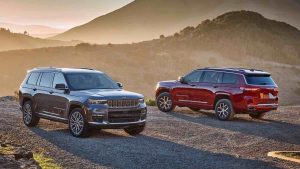
Prices start at $40,325 for the base Laredo trim – of the Grand Cherokee L – as opposed to $38,325 for the same thing in a two-row Grand Cherokee sans the L (and the additional length. Both come standard with the same 3.6 liter V6, paired with an eight speed automatic – and the option to buy 4WD.
Several types of 4WD are available, ranging from the base system – which does not have a two speed transfer case and Low Range gearing to one with a manually engaged Low range and – thirdly – one that engages everything except 4WD Low automatically.
Both are also available with V8 power – in the Overland and Summit Trims, which sticker for $56,240 and $60,300 to start, respectively, for the GC L and $54,200/$58,300 also respectively, for the GC. 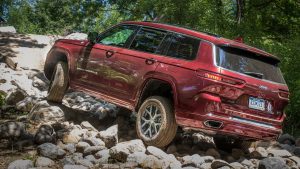
There is one other difference between these two versions of the same basic thing. You can’t get the L with the extreme off-road Trailhawk package (Goodyear all-terrain tires, electrically disconnecting front stabilizer bar, tow hooks, etc.) though some of the individual components that make it up can be added, a la carte.
Also, the hybrid drivetrain that’s available with the two-row-only GC isn’t available with the L.
Probably – as regards the latter – because of the extra weight that comes with the additional length (and seats). 
What’s New
The GC L is now available with the passenger-side LCD screen that made its debut in the two-row GC. You can also get the L with Amazon Fire TV for the rear-seaters.
In addition to that, Jeep has added a Black appearance package (20 inch black anodized wheels and trim) you can opt for with the Limited and a High Altitude package (21 inch wheels and black/gray accents) that can be added to the Summit. 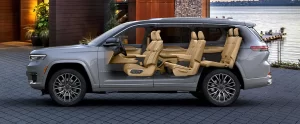
What’s Good
One more row – not much more cost.
More total cargo capacity, too.
Standard V6 – available V8.
What’s Not So Good
Less cargo capacity behind the third row than the two-row has behind its second row.
V8 is restricted to much-pricier Overland and Summit trims.
Automated Stop-Start has to be turned off every time you start out – unless you want the engine to stop-start every time you go for a drive.
The GC L comes standard with the same 3.6 liter V6 that’s standard in the . . . standard GC. It makes 293 horsepower and 260 ft.-lbs. of torque and is paired with an eight speed automatic transmission. This powers either the rear wheels or your pick of three different four-wheel-drive systems, Quadra Trac 1, Quadra Trac II or Quadra Drive II. The first is more like the all-wheel-drive set-ups that are available in most crossovers in that it does not have a two-speed transfer case and so doesn’t have the down-low leverage advantage of 4WD Low range gearing. It differs from most of the AWD systems in most crossovers in that most of the time, most of the engine’s power is routed to the rear rather than the front wheels. It’s the reverse in most AWD crossovers because most of them are based on car-type front-wheel-drive layouts that bias the power distribution to the front wheels – until the rear wheels begin to lose grip. 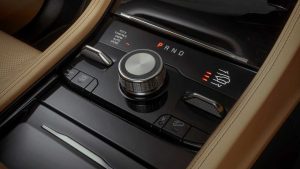
But the GC L (and GC, standard) are SUVs – and built on rear-drive layouts, similar to most trucks. Most of the engine’s power goes to the rear rather than front wheels, which receive some when the rear wheels begin to lose their grip. The difference here isn’t so much traction as it is feel. The rear-drive-bias feels more balanced, because it is. The weight of the drivetrain being more evenly spread out from front-to-rear than in a FWD/AWD crossover, which has more of its drivetrain bunched up front. It’s also sturdier – able to handle more load – due to the heavier-duty rear axle and more rugged chassis it’s bolted to. That’s why the V6-powered GC L can pull 6,200 lbs. – about 1,200 pounds more than the typical same-sized V6-powered crossover can safely manage.
The next-available 4WD system – Quadra Trac II – adds the two-speed transfer case and Low range gearing, which greatly increases the available mechanical leverage at low speeds vs. AWD-equipped crossovers that lack it. This system also features a neutral range that – when engaged – allows all four wheels to freely rotate, which means the GC L so equipped can be towed with two wheels on the ground as opposed to being carried on a flatbed.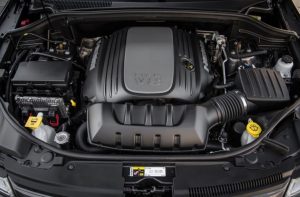
Quadra Drive II is mechanically similar – but differs in having a 4WD High range that engages automatically (the driver doesn’t have to engage it).
For more engine, there’s the optional 5.7 liter Hemi V8, making 357 horsepower and 390 ft.-lbs. of torque. It stands out because there are so few V8s still available – even in SUVs. Unfortunately, it is only available in the Overland and Summit trims, which are substantially more expensive than the entry-level Laredo and next-up Altitude and Limited trims – economically limiting the number of people who’ll be able to buy it.
Interestingly, Jeep does not offer the GC L with the plug-in hybrid combo that’s available with the standard GC. It combines a 2.0 liter four with a battery pack and motors to summon 375 horsepower and 470 ft.-lbs. of torque – more of both than summoned by the optional 5.7 liter Hemi. 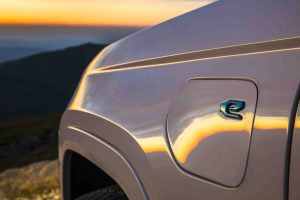
But it also summons more weight.
The plug-in hybrid version of the GC has a curb weight of 5,325 lbs. (vs. 4,238 lbs. for the V6-powered GC). Since the larger/longer-wheelbase GC L already weighs 4,618 lbs. (380 lbs. more than the standard GC) adding another 1,087 lbs. – the additional weight of the plug-in’s battery pack and motors – would push the curb weight of a hypothetical GC L hybrid upward by 1,467 lbs. vs. the already beefy curb weight of the standard-length GC, whatever might have been gained in power would have been negated by weight. The electric-only (and electric assisted) range of a hypothetical plug-in GC L would also likely be less than the 25 miles or so the two-row hybrid GC can go – and so probably enough to not make it worth the bother.
Interestingly, even in the lighter GC, the plug-in only manages 23 city, 24 highway – no great shakes vs. the V6 GC L’s 19 city, 26 highway with the V6. Or even vs. the GC L’s available V8, which rates 14 city, 22 highway. Especially in view of the plug-in hybrid’s $55,865 base price, which is nearly as high as the price of the GC L Overland ($56,240) without the extra row – or the extra room.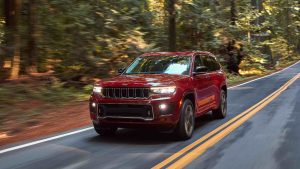
On The Road
You may have read that the GC L – with the V6 – is slow. In relative, by-the-stopwatch terms, this is true. Zero to 60 needs just shy of 8 seconds, which isn’t as quick as some of the V6-powered crossovers the Jeep is often compared with, such as the Kia Telluride and its Hyundai cousin, the Palisade. These get to 60 in about 7 seconds. But they are crossovers – built on front-drive layouts (with AWD available).
4WD isn’t.
That, however isn’t even the point. The point is that almost every type of vehicle you’ll encounter on the road is under-driven. As in, the capability it has – including its ability to accelerate – isn’t generally used to the full. In many cases, even the half. The difference, all out between just shy of eight seconds and a little more than 7 seconds is blink-of-an eye, hard to register without instruments. It’s about two-thirds of a car length at the end of a side-by-side 0-60 run.
And how often do you run all-out?
In everyday driving, the V6 Jeep has sufficient power.
The eight speed automatic shifts sharply when asked to (in Sport mode) making the thing feel quicker than the numbers convey.
And unlike all of its crossover competitors, you can make it actually quick by picking the available V8. Zero to 60 drops to 6 seconds-ish and that’s quick enough to keep within two or three car lengths of a Mustang GT or Camaro from stoplight to stoplight. Tragically, there is no Trackhawk iteration of the GC L, powered by a supercharged version of the Hemi V8. Even more tragically, the Trackhawk version of the two-row GC no longer is, either.
What the GC L offers is the full-size luxury SUV (as opposed to crossover) experience, which can be experienced at a price point well below that of luxury-badged models such as the Genesis GV80 and Land Rover Range Rover that are also smaller (standard GC size) and two-rows only. Or – as in the case of the Benz GLE – two rows usually.
This Jeep’s main competitor may prove to be the newest Jeep model – the even bigger Wagoneer. That one also comes standard with a 392 horsepower version of the GC L’s available Hemi V8. An even stronger (and larger) version is also available, in the Grand Wagoneer.
But these are also priced well above the price of the GC L – which nonetheless offers much of the same ultra-premium gear, such as multi-mode massaging seats – as well as ruggedness/capability that’s hard to find in another SUV for a comparable price.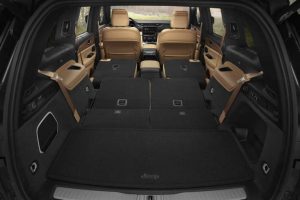
At The Curb
Size matters – literally.
The GC L is big enough to accommodate a third row that’s adult-usable without becoming so big, itself, as to be too big for people who’d like the extra seats but not if it means graduating to something really big . . . like the Wagoneer. That one is 214.7 inches long vs. 204.9 inches for the GC L (vs. 193.5 for the two-row GC).
The GC L thus bridges the gap between mid-sized SUVs like the two-row GC and full-size SUVs like its Wagoneer bigger brother. It is not quite as big – or as long – as a Chevy Tahoe or Ford Expedition, both of which extend beyond 225 inches – but it seats as many about as comfortably.
You can slide the second row captain’s chairs through seven inches of travel, to fine-tune the legroom in both the second and third rows. The third row is available with push-button power folders that can be adjusted individually and the second row seats also tilt forward individually, to open access to the third for passengers.
With the third row down, you can carry longer items with the liftgate down that would require leaving it partially open in the two-row GC. Total cargo capacity goes up to 84.6 cubic feet vs. 70.8 in its smaller sibling. It’s enough to haul an 80-inches log casement window sash without having to push the second row seats forward.
However, with the third row in use, cargo capacity reduces to 17.2 cubic feet from 37.7 in the two-row.
Summit trims come with driver and front seat passenger massaging seats and Jeep’s Quadra Lift, driver-adjustable air suspension that lets you raise or lower the ride height to suit. Plus an upgraded nine speaker audio system and four zone climate control. The top-of-the-line Summit Reserve includes a 19 speaker McIntosh ultra-premium audio system and an additional LCD screen for the front seat passenger to pipe Fire TV through. The latter can be added as an a la carte option in other trims.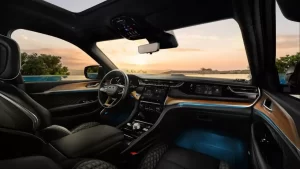
Also standard is the top-of-the-line Quadra Drive II 4WD system, which features fully automatic 4WD high range and five driver-selectable terrain modes (Rock, Sand/Mud, Snow, Auto, Sport) plus 4WD low, engaged via a button on the center console.
The Jeep LCD interface – UConnect – is one of the best available in that it’s just as easy to use as old-school buttons and knobs – because it has them. You can, for example, manually fine-tune the station you’re listening to using a knob rather than a clumsy tap-swipe.
The Rest
Just a few nits to pick, the first one being that the hateful automatic engine stop-start “technology” that comes standard with this Jeep – as it does with practically all new vehicles, which it does because of regulatory compliance pressures (e.g., CAFE fuel economy and “greenhouse gas emissions” regs) has to be manually turned off every time you go for a drive, if you don’t want the engine to stop every time the Jeep does. It’s a small thing but the small annoyance of the thing accumulates with each drive.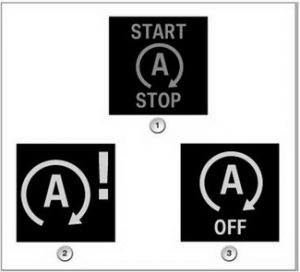
There is probably a way to turn it off/disable it permanently; the dealer may know how. Ask him to do it as a prior condition of purchase.
The other relates to the former.
A vehicle like this really ought to come standard with a V8. But the V8 is restricted to the very top-two trims; ironically in order to limit the number of people who buy the V8. If that sounds strange, it is. You’d think Jeep would want as many people as possible to buy the V8, as it would mean more money for Jeep. But the more who buy the V8, the lower Jeep’s overall Corporate Average Fuel Economy numbers – and the higher the “gas guzzler” fines applied by the government. These are then folded into the sticker price of Jeeps generally, to transfer the cost of government to the buyer. But buyers become less likely to buy as prices go up.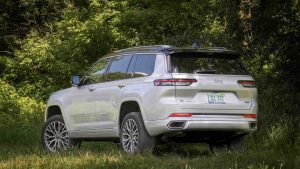
That’s why Jeep has made the V8 an option – and only in the higher trims. The effect being that only more affluent people can afford to buy them.
Thank Uncle for that.
The Bottom Line
That business about not too small, not too big – but just right – applies to the Grand Cherokee L.
. . .
Got a question about cars, bikes or anything else? Click on the “ask Eric” link and send ’em in! Or email me directly at EPeters952@yahoo.com if the @!** “ask Eric” button doesn’t work!
If you like what you’ve found here please consider supporting EPautos.
We depend on you to keep the wheels turning!
Our donate button is here.
If you prefer not to use PayPal, our mailing address is:
EPautos
721 Hummingbird Lane SE
Copper Hill, VA 24079
PS: Get an EPautos magnet or sticker or coaster in return for a $20 or more one-time donation or a $10 or more monthly recurring donation. (Please be sure to tell us you want a magnet or sticker or coaster – and also, provide an address, so we know where to mail the thing!)
My eBook about car buying (new and used) is also available for your favorite price – free! Click here. If that fails, email me at EPeters952@yahoo.com and I will send you a copy directly!


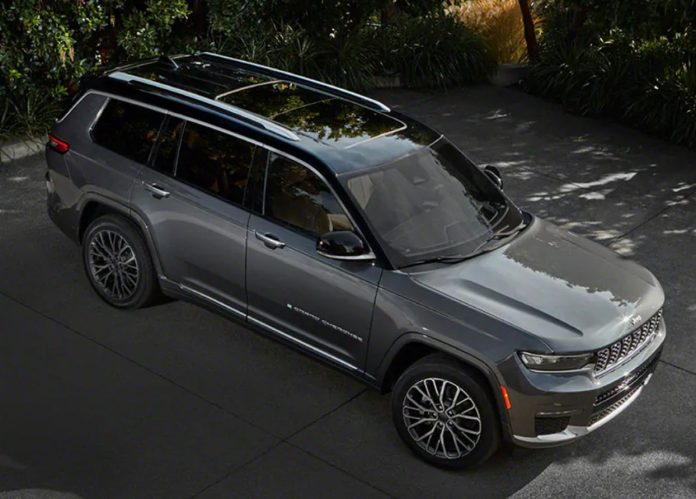

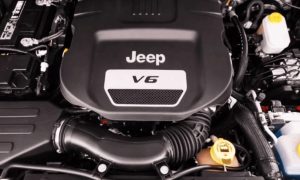









As far as ASS goes, most new vehicles can have that function permanently disabled with one of the semi-expensive OBD II scanners.
Many other functions (how the doors lock/unlock for instance) can also be customized with one of those scanners.
Now, I don’t know if that would have warranty impact.
Hi ndb,
Hat tip for the . . . tip! I have a scan tool; I may try to play around with this – though I probably shouldn’t with other people’s press cars!
I had a 2012 JGC and it was a great grocery getter. That’s about it. It did nothing great but everything just ok. On the highway it cruised above 80mph well with street tires.
On this one the third row option would be better as one could then take seats out and have room to add refrigerator, storage, sleeping, gear. V8-357hp? Should be able to modify that some. I don’t see many newer GCs off road so probably not a aftermarket for mods. Jeeps prior to 2010 yes.
Re: Automated Stop-Start has to be turned off every time you start out – unless you want the engine to stop-start every time you go for a drive.
Are you sure this is true for the V8 version? I have a ’19 GC V8 now, a ’20 Ram V8 and a ’21 Ram V8 and in all of them ASS can be turned off permanently. I reasoned that the V8 would be inhibitive of being turned off-and-on all the time.
Great review as always. Thanks.
Any idea when they are going to put their new straight 6 in these? I want to buy the last V8 GC avail before they do it.
Hi Chris,
I think so. My test mule had the V6. I’ll have to see what I can find. But I suspect all the ’22s have this now and I expect that, soon, there won’t even be an Off button. This is how the acclimate people to such “technology.” Same as regards Lane Keep and other forms of “assistance,” too.
my reasoning from an engineering standpoint is ASS on a V8 is not good mechanically/electrically. And that’s why I thought FCA didn’t do it. Although Ford does it with their 5.0 V8, so there’s that. But I was able to defeat fords permanently with a paperclip.
If they now do it too, crappola…………………………………
seems like the kind of thing I’d want if they ever kill the Jab mandate and I can come over to the US 😛 😛 :P…..
That said it quite sad that a car which was meant for getting out and seeing the beauty of the world now brags about screens for the front passenger and even “amazon fire” screens for the rear passengers. The whole point of getting out of the house being to not stare at screens…
Just one point Eric it would be interesting if you can add on your reviews (and something obviously no car journalist does) – the privacy rating. Say how much google / amazon shit is in there. How much the thing listens to you, and how much you can turn off (or not get)….. I mean if a car has some standard amazon / google thing in it, I’d steer well clear…. find it annoying how every company here tries to send me free amazon / google “smart” (AKA spy) devices for “free”….. now they are coming standard on cars here!!
Hi Nasir,
To one degree or another, practically all new cars have some form of “connectivity.” It is usually marketed as a “concierge/roadside assistance” thing. Or it is overt, right in front of you, almost – piped through the LCD “infotainment” screen, which is the interface for the “apps” so many people seem to crave. (Aside: I despise these adolescent terms; e.g., “apps.” The Millennials being to blame for it all as us Gen X and older people knew we weren’t 16 anymore after we turned 30).
The other day, I was checking out a 2010 Ford Fusion bought by the kid nephew of a friend of mine. What a refreshing car. No goddamn LCD screen. No “apps” or “assistance.” Just a got-verdammt car. One that doesn’t parent or narc you out. Power windows, locks, AC. Just you and the car along for the ride. I told the kid what a find he’d found – and to hold onto it for dear life, as long as possible.
Eric – this reminds me of something Jeremy Clarkson once said about these new SUV/offroad cars (this itself was about 10+ years ago). It was on the lines of “when you’re stuck off road you want to be able to pull a lever and metal to move and go clunk. When you push a button and a light comes on – you wonder what will that little light do, how will it get you going again !
The button and light was much more substance than swiping on a screen looking for a menu in an “app” !!
Amen, Nasir –
I used to have a ’98 4WD truck with manual-locking hubs and a lever you pulled to engage the 4WD Low. It was tactile. You felt the engagement – and it felt like something just happened. Pushing a button? Yet, this is what (apparently) lots of people want, instead. I find it anodyne, disconnected. Milquetoast. Unreal.
as much as I am a mechanical geek, I do like the push button 4wd stuff. Sorry.
The game changer for me was auto-4wd, so I could leave it in driving partial snow/blacktop without binding the drivetrain. I still go full 4wd when there is no blacktop showing so I can get the braking aspect of it too if needed cause I almost always drive too fast for conditions.
But I don’t keep vehicles past 5 years, so there’s that perspective.
I call it pick your poison.
Indeed, Chris!
I keep mine until I can’t – as in the case of my ’98 Frontier, which passed the point of no (economic) return as far as frame rust. The tragic thing was it ran great – and if it had been just the frame I probably would have kept it and still have it. But the fuel and brake lines, all the small stuff that works up to big stuff, was also corroding rapidly. So I sold her to a local guy who uses it to haul stuff to the dump. It’s still doing that, too, as far as I know…
Nice Waffle House motif inside! Hopefully these seats more comfortable than the side seams of prior years.
It’s too bad they don’t bring back the corrugated cloth seats of say, 1995 or so.
My buddies 1995 Grand Cherokee super comfortable cloth bucket seats, as is the similar material in my 1991 Silverado bench seat. Also they hold up better than leather and no sweaty butt summers.
The V6 with the 8 speed is a nice combo, my 2018 has this and the motor has enough power it isn’t constantly shifting plus will tow with ease.
I’d be much happier if it didn’t want to change lanes in a cross wind.
Has the grand cherokee gotten smaller over the years? I swear these used to be taller and longer.
I know it’s how things are going, but it is disappointing that Jeeps come with AWD and not just good old 4×4.
Probably more capable than your standard SUV, but I hate the price tag. I can get a HD truck for that money.